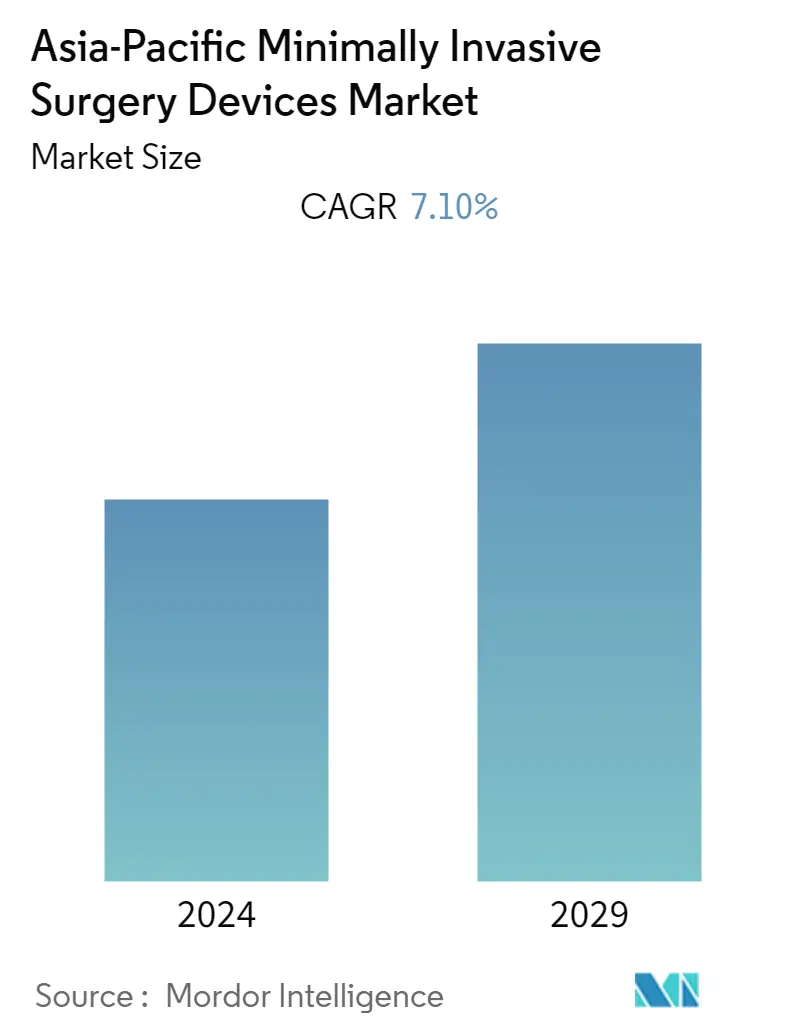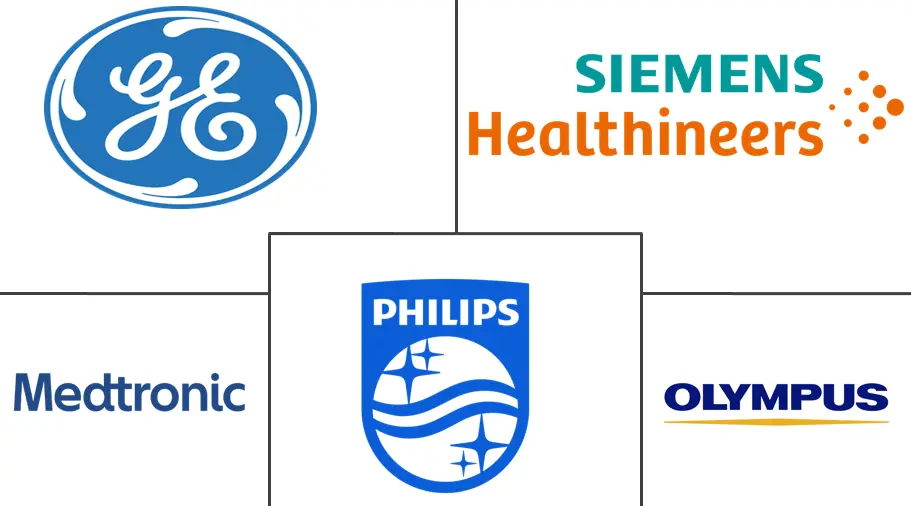Market Size of Asia-Pacific Minimally Invasive Surgery Devices Industry

| Study Period | 2019 - 2029 |
| Base Year For Estimation | 2023 |
| Forecast Data Period | 2024 - 2029 |
| Historical Data Period | 2019 - 2022 |
| CAGR | 7.10 % |
Major Players
*Disclaimer: Major Players sorted in no particular order |
APAC Minimally Invasive Devices Market Analysis
The Asia-Pacific minimally invasive surgery devices market is expected to register a CAGR of 7.1% during the forecast period.
The COVID-19 pandemic has had an impact on a variety of surgical techniques, including minimally invasive ones. Due to the strict restrictions, patients with various lifestyle-related and chronic diseases experienced a delay in diagnosis and treatment due to fewer hospital visits which hampered the market studied. According to the January 2022 published study in the JMAS, overall elective operations and minimally invasive surgery (MIS) were reduced proportionally in India. Across the country, most surgeons reported a drop in overall elective surgical volume (93.2%) and MIS cases (88.4%). There was a corresponding decline in laparoscopic, thoracoscopic, and robotic cases among MIS cases across the country. As a result, in the early stages of the outbreak, COVID-19 harmed market growth. However, since the restrictions were lifted, the industry has recovered well. Over the last two years, the market recovery has been led by the high prevalence of diseases, new product launches, and increased demand for minimally invasive surgeries.
The major factors for the growth of the Asia-Pacific minimally invasive surgery devices market include the increasing prevalence of lifestyle-related and chronic disorders and technological advancements. Alterations in metabolic activity and lifestyle changes are linked to cardiovascular risk, and the rising incidence of cardiovascular diseases is expected to propel the growth of the market. According to the article published in a White paper in May 2022, atherosclerotic cardiovascular disease (ASCVD) resulted in significant productivity loss in the Asia-Pacific region, including several countries such as Vietnam.
Cancer cases are also rising across the Asia-Pacific region, along with the demand for minimally invasive surgeries, which is expected to boost the demand for MIS devices. For instance, as per the Globocan 2020 statistics, the estimated number of new cancer cases was 9,503,710, and the number of prevalent cases (5 years) was 20,606,063 in the Asia-Pacific region in 2020. Among these, new cases of lung cancer were the highest, with 1,315,136 (13.8%) cases, followed by breast cancer cases at 1,026,171 (10.8%) in 2020. Thus, the high burden of cancer is expected to boost the demand for MIS devices during the forecast period.
Furthermore, there are various advantages of MIS over other surgeries, which are also likely to support market expansion. Minimally invasive surgeries (MIS) cause less post-operative pain, and patients receive smaller dosages of painkillers. As there are minimal cuts or stitches involved, the hospital stay is relatively short, and patients need not visit the hospital frequently. In addition, minimally invasive surgeries (MIS) provide a more detailed and magnified image of the organs or body parts operated on and increased precision due to video-assisted technology.
Moreover, various strategies adopted by key market players, such as product launches, mergers and acquisitions, and partnerships, are expected to support market growth. For instance, in June 2021, Pentax Medical formed a new joint venture (JV) with Jiangsu Vedkang Medical Science and Technology (Vedkang) to develop endoscopic therapies. Therapeutic devices and flexible medical endoscopes are used in minimally invasive procedures to benefit patients, physicians, and healthcare systems by dramatically reducing procedure cost/complexity and improving patient recovery time. As a result of the advantages associated with minimally invasive operations, the market is likely to expand during the forecast period.
However, a shortage of experienced professionals may restrain the market growth.
APAC Minimally Invasive Devices Industry Segmentation
Minimally-invasive surgical devices refer to electrosurgical systems, robot-assisted surgical systems, and surgical equipment, which are used during the minimally-invasive procedure.
The Asia-Pacific minimally invasive surgery devices market is segmented by product (handheld instruments, guiding devices (guiding catheter, and guidewires), electrosurgical devices, endoscopic devices, laparoscopic devices, monitoring, visualization devices, ablation devices, laser-based devices, robotic-assisted surgical systems, and other MIS devices), application (aesthetic, cardiovascular, gastrointestinal, gynaecological, orthopaedic, urological, and other applications), and geography(China, Japan, India, Australia, South Korea, Rest of Asia-Pacific). The report offers the value (in USD million) for the above segments.
| By Products | ||||
| Handheld Instruments | ||||
| ||||
| Electrosurgical Devices | ||||
| Endoscopic Devices | ||||
| Laproscopic Devices | ||||
| Monitoring and Visualization Devices | ||||
| Robotic Assisted Surgical Systems | ||||
| Ablation Devices | ||||
| Laser-based Devices | ||||
| Other MIS Devices |
| By Application | |
| Aesthetic | |
| Cardiovascular | |
| Gastrointestinal | |
| Gynecological | |
| Orthopedic | |
| Urological | |
| Other Applications |
| Geography | |
| China | |
| Japan | |
| India | |
| Australia | |
| South Korea | |
| Rest of Asia-Pacific |
Asia-Pacific Minimally Invasive Surgery Devices Market Size Summary
The Asia-Pacific minimally invasive surgery devices market is poised for significant growth, driven by the increasing prevalence of lifestyle-related and chronic disorders, alongside technological advancements. The market experienced initial setbacks due to the COVID-19 pandemic, which led to delays in diagnosis and treatment as elective surgeries were postponed. However, the market has since rebounded, supported by a rise in disease prevalence, new product launches, and a growing demand for minimally invasive procedures. The advantages of minimally invasive surgeries, such as reduced post-operative pain, shorter hospital stays, and enhanced precision through video-assisted technology, are further propelling market expansion. Key players in the industry are actively engaging in strategies like product launches, mergers, and partnerships to strengthen their market position and drive growth.
China is expected to hold a significant share of the market, fueled by the increasing prevalence of chronic diseases and a growing geriatric population. The country's rapid aging process and the associated rise in chronic illnesses, such as cardiovascular diseases and cancer, are anticipated to bolster market growth. Companies are focusing on developing advanced products to meet the complex requirements of cardiac procedures, further supporting market expansion. The market is characterized by a few dominant players, including Abbott Laboratories, GE Healthcare, and Medtronic PLC, who are continuously innovating and expanding their product portfolios. These factors, combined with strategic collaborations and regulatory approvals, are expected to propel the growth of the Asia-Pacific minimally invasive surgery devices market during the forecast period.
Asia-Pacific Minimally Invasive Surgery Devices Market Size - Table of Contents
-
1. MARKET DYNAMICS
-
1.1 Market Overview
-
1.2 Market Drivers
-
1.2.1 Increasing Prevalence of Lifestyle-related and Chronic Diseases
-
1.2.2 Technological Advancements
-
-
1.3 Market Restraints
-
1.3.1 Shortage of Experienced Professionals
-
-
1.4 Porter's Five Force Analysis
-
1.4.1 Threat of New Entrants
-
1.4.2 Bargaining Power of Buyers/Consumers
-
1.4.3 Bargaining Power of Suppliers
-
1.4.4 Threat of Substitute Products
-
1.4.5 Intensity of Competitive Rivalry
-
-
-
2. MARKET SEGMENTATION (Market Size by Value - USD Million)
-
2.1 By Products
-
2.1.1 Handheld Instruments
-
2.1.2 Guiding Devices
-
2.1.2.1 Guiding Catheters
-
2.1.2.2 Guidewires
-
-
2.1.3 Electrosurgical Devices
-
2.1.4 Endoscopic Devices
-
2.1.5 Laproscopic Devices
-
2.1.6 Monitoring and Visualization Devices
-
2.1.7 Robotic Assisted Surgical Systems
-
2.1.8 Ablation Devices
-
2.1.9 Laser-based Devices
-
2.1.10 Other MIS Devices
-
-
2.2 By Application
-
2.2.1 Aesthetic
-
2.2.2 Cardiovascular
-
2.2.3 Gastrointestinal
-
2.2.4 Gynecological
-
2.2.5 Orthopedic
-
2.2.6 Urological
-
2.2.7 Other Applications
-
-
2.3 Geography
-
2.3.1 China
-
2.3.2 Japan
-
2.3.3 India
-
2.3.4 Australia
-
2.3.5 South Korea
-
2.3.6 Rest of Asia-Pacific
-
-
Asia-Pacific Minimally Invasive Surgery Devices Market Size FAQs
What is the current Asia-Pacific Minimally Invasive Surgery Devices Market size?
The Asia-Pacific Minimally Invasive Surgery Devices Market is projected to register a CAGR of 7.10% during the forecast period (2024-2029)
Who are the key players in Asia-Pacific Minimally Invasive Surgery Devices Market?
Medtronic PLC, Olympus Corporation, Siemens Healthineers, Koninklijke Philips NV and GE Healthcare are the major companies operating in the Asia-Pacific Minimally Invasive Surgery Devices Market.

